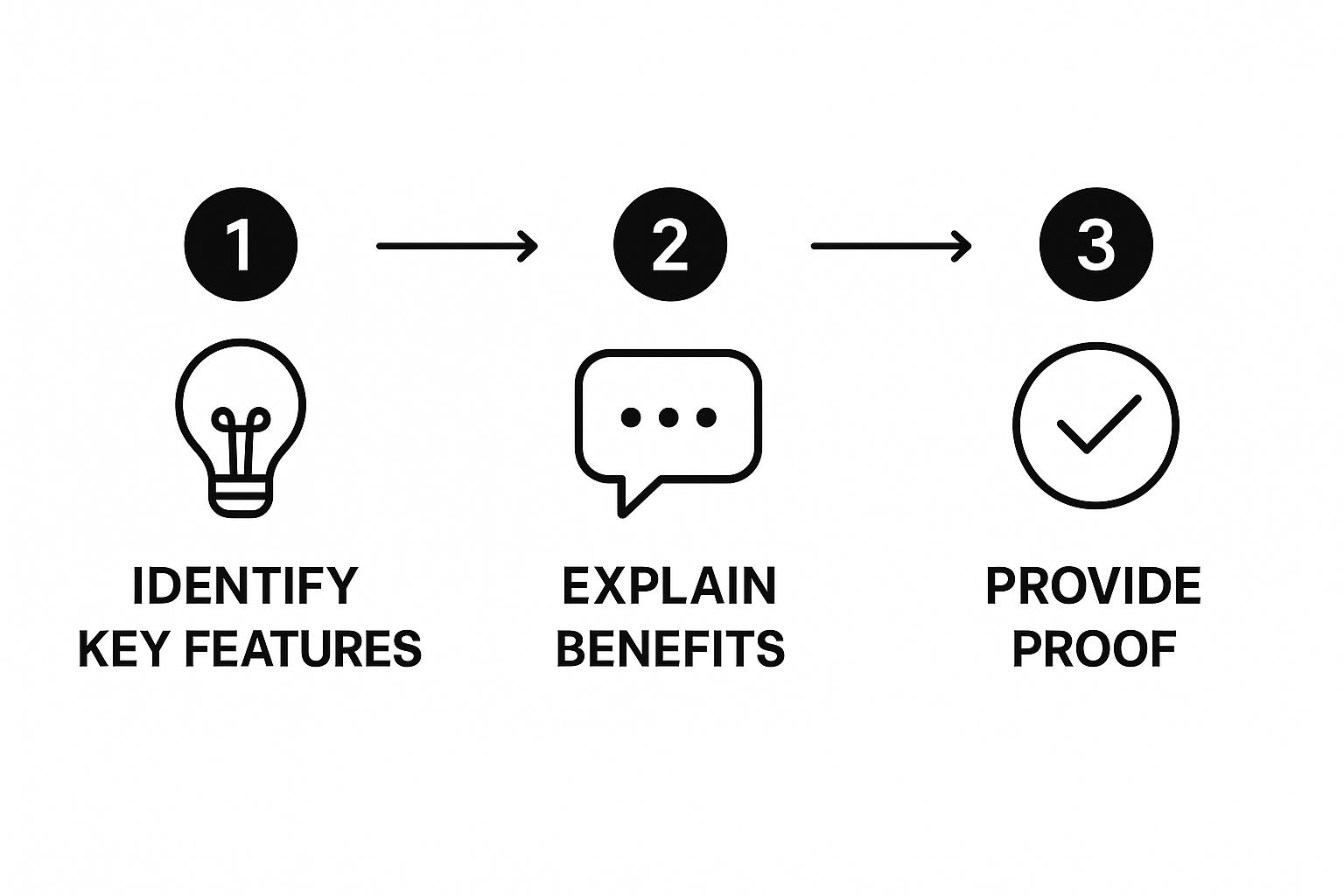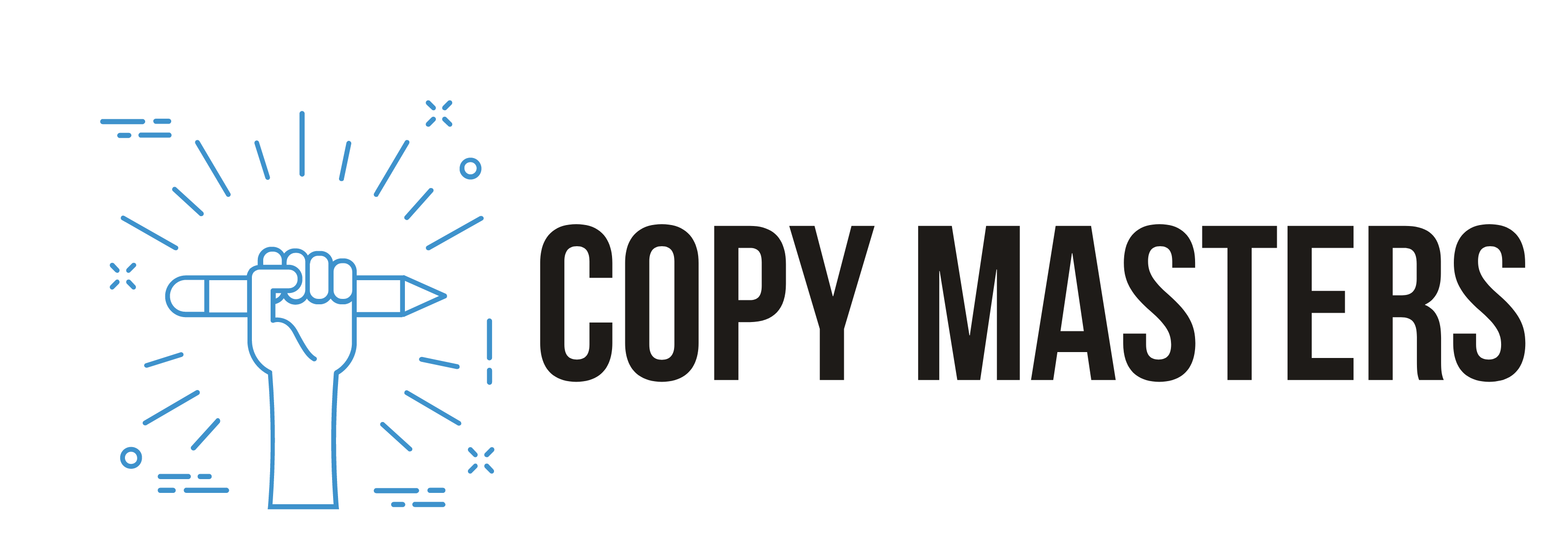You can’t just list features and call it a day. A product description is your chance to tell a story—one that connects a real customer's problem with the solution you’re selling. When you get it right, that description works for you around the clock, like your best, most convincing salesperson. It builds trust, calms those last-minute buying jitters, and ultimately, turns a list of specs into a must-have benefit.
The Hidden Power of a Great Product Description

Let's be honest. Most product pages are a snooze-fest. They’re filled with dry, uninspired text—a laundry list of technical specs and dimensions that reads like an instruction manual. Treating the description as an afterthought is a huge missed opportunity to actually connect with someone.
A powerful product description does more than just inform; it persuades. This is your chance to get inside your customer's head, show them you understand their problem, and position your product as the perfect fix. It’s not just about pushing for a quick sale; it’s about building a relationship and earning their trust right from the start.
From Chore to Strategic Growth Lever
When you stop seeing product descriptions as a tedious chore and start treating them as a strategic tool, everything changes. Solid copy directly impacts your bottom line. It can slash cart abandonment rates, boost conversions, and even cut down on returns because you’ve set clear, accurate expectations.
The heart of it all is figuring out what makes your product genuinely different. What’s your unique value? Diving into some effective unique selling proposition examples is a great way to see how other brands make themselves stand out in a crowded market.
A great product description closes the gap between the customer's problem and your product's solution. It’s not just about what your product is, but what it does for them.
This skill is only getting more important. Think about it: the global market for copywriting services was valued at USD 8.5 billion in 2023 and is expected to nearly double to USD 16.4 billion by 2032. That kind of explosive growth tells you one thing—businesses are finally realizing that words are one of the most powerful tools they have for winning in e-commerce.
Getting a handle on this "why" is the first real step. It reframes the whole process. Now, every word you choose has a clear purpose: to convince your customer that your product is exactly what they’ve been looking for.
Before we dive into the "how," let's quickly break down the essential pieces that make up a description that actually sells. Think of this table as your roadmap for everything that follows.
Key Elements of a High-Converting Product Description
| Component | Purpose | Example Snippet |
|---|---|---|
| Hooking Headline | Grabs attention and summarizes the main benefit in a single, punchy line. | "The Last Travel Mug You'll Ever Need." |
| Benefit-Driven Body | Translates features into tangible benefits that solve the customer's problems. | "Its double-wall insulation means your coffee stays hot for 12 hours…" |
| Scannable Format | Uses bullet points and short paragraphs to make information easy to digest. | • Leak-proof lid • Dishwasher safe • Fits standard cup holders |
| Brand Voice | Infuses personality and builds a connection with the target audience. | "Tired of lukewarm coffee? We were too. That's why we built the InfernoMug." |
| Social Proof | Builds trust and credibility through reviews, ratings, or testimonials. | "Join over 50,000 happy commuters who start their day right." |
| Clear Call-to-Action | Tells the customer exactly what to do next, removing friction. | "Click 'Add to Cart' to lock in your price." |
Keep these six elements in mind as we go. They're the building blocks we'll use to construct product descriptions that not only attract search engines but also convert visitors into loyal customers.
Laying the Groundwork Before You Write a Word
Great product descriptions don't just happen by magic. They’re the result of good, old-fashioned homework. Before you even think about crafting a catchy headline, you need to dig in and really understand who you’re talking to, what keeps them up at night, and why your product is the answer they’ve been looking for.
Skipping this part is like trying to build a house without a blueprint. You might end up with something that stands, but it's not going to be what anyone actually wants to live in. This upfront work makes the writing itself faster, easier, and infinitely more effective. You’re gathering the raw materials—the exact words, pain points, and desires—that will form the core of your message.
Define Your Ideal Buyer
You can't sell to everybody. When you try to write for a general audience, your copy becomes watered-down and forgettable, connecting with no one. What you need is a sharp, clear picture of your perfect customer. What are they trying to achieve? What drives them crazy? What’s their sense of humor like?
Creating a simple buyer persona helps you step directly into their shoes. Give this person a name, a job, and a real reason they’re looking at your product. This isn’t about some massive market research project; it’s about building enough empathy to write to a person, not at a demographic. For a much deeper look, we have a complete guide on how to research a target audience that lays out the exact steps.
Mine for Gold in Customer Reviews
Here’s a secret: your customers are already telling you everything you need to know. You just have to listen. Customer reviews, whether they're on your site or a competitor's, are an absolute goldmine of authentic language and real-world problems.
Look for patterns and specific phrases people use over and over. Pay close attention to how they describe their frustrations before they found a solution. These are the very words you should be using in your own descriptions.
- Positive Reviews: What specific features get all the love? Are people mentioning benefits you hadn't even thought of?
- Negative Reviews: What were their biggest letdowns? Did the product fail to deliver on a specific promise? This is crucial, as it reveals the anxieties you must address head-on.
When a customer complains that a competitor's backpack "didn't have a separate padded pocket for a laptop," they're basically writing your copy for you. Your description can now say, "Features a dedicated, fleece-lined sleeve to keep your tech safe."
This research directly feeds into your core message. The workflow below shows how to spin these insights into a story that sells.

This process is simple but incredibly powerful: start with what the product does (features), translate that into how it helps (benefits), and then back it all up with proof.
Pinpoint Your Unique Value Proposition
Okay, once you've got a handle on your audience and their needs, it's time to define your unique value proposition (UVP). What makes your product the absolute best choice out of all the other options?
Don't just spit out a list of features. Figure out what truly makes you different. Is it your commitment to sustainable materials? Your unbeatable lifetime warranty? Maybe it's your legendary customer service.
Your UVP becomes the North Star for your product description. Every feature, every benefit, every word you write should tie back to this core idea, making it painfully obvious to the customer that your product isn't just an option—it's the only one that makes sense for them.
Crafting Copy That Connects and Converts

Alright, you've done the legwork and gathered all that fantastic customer research. Now for the fun part: turning those raw insights into words that actually sell. This is where you take everything you've learned—your customer's biggest headaches, their secret wishes, and the exact words they use—and weave it into copy that makes them feel understood.
The real goal here isn't just to describe what your product is. It’s to paint a picture of how much better their life will be with your product in it.
The most important shift in mindset is this: sell the outcome, not the item. It’s a classic for a reason. Nobody buys a drill because they're dying to own a drill; they buy it because they need a hole in the wall. Your copy needs to connect those dots, translating every feature into a real-world, can't-live-without-it benefit.
Turning Features Into Benefits
Let’s get practical. A feature is a dry, factual statement about your product. A benefit is the positive punch it delivers to your customer.
A dead-simple trick I use to bridge this gap is to add phrases like "which means…" or "so you can…" after every feature I list. This little exercise forces you to explain why anyone should care.
Here’s an example for a high-end blender:
- Feature: "1400-watt motor." (Okay, and?)
- Benefit: "The powerful 1400-watt motor pulverizes ice and frozen fruit in seconds, so you can enjoy perfectly smooth, café-quality smoothies without any of that annoying gritty texture."
See the difference? We went from a boring spec to the delightful experience of a perfect smoothie. You’re not just selling a motor; you’re selling a better morning ritual.
Using Copywriting Formulas to Guide You
You don't have to stare at a blank page and hope for inspiration. Proven copywriting formulas give you a solid framework to build on. One of the most reliable is the PAS formula—it’s a classic because it works.
- Problem: Call out a specific pain point your customer deals with every day.
- Agitate: Pour a little salt in the wound. Remind them just how frustrating and annoying that problem really is.
- Solution: Present your product as the obvious, welcome relief to their suffering.
Let’s say you’re selling noise-canceling headphones. Using the PAS formula, your copy could flow like this:
(P) Trying to focus on a busy train or in a loud coffee shop feels impossible. (A) That constant background chatter just shatters your concentration and makes it hard to simply relax with your favorite music. (S) Our Quietude Headphones use advanced active noise-cancellation to create your own personal bubble of silence, letting you finally hear yourself think.
This structure is effective because it mirrors the customer's own thought process. It taps into an existing frustration and makes your solution feel like the answer they've been searching for. If you want to go deeper, you can explore the 6 principles of persuasion to attract your target audience to make your copy even more magnetic.
Finding Your Brand Voice
The final, crucial layer is your brand voice. Are you the witty, playful friend or the trusted, authoritative expert? Your tone needs to be consistent, creating a seamless and memorable experience for shoppers as they browse your site.
Your voice should be a blend of your brand's personality and what your ideal customer expects to hear. If you’re selling skateboards, a stuffy, corporate tone is going to be a total miss. On the flip side, if you're selling high-end financial software, using a bunch of casual slang will quickly erode trust.
A consistent voice does more than just sound nice—it builds recognition and a real sense of community. When customers feel like your brand gets them, they’re much more likely to stick around and become your biggest fans. Think of it as the personality that makes people want to do business with you.
Optimizing Your Descriptions for Search Engines
Writing amazing copy is half the battle. If your customers can't find your products, even the most persuasive description won't matter. This is where search engine optimization (SEO) comes in, transforming your product page from a lonely digital flyer into a powerful magnet for organic traffic.
The goal isn't to game the system or trick Google. It's about clarity. You're simply helping search engines understand what your product is and who it's for, so they can connect you with the right people at the right moment.
Remember this golden rule: write for humans first, search engines second. The era of stuffing pages with robotic keywords is long gone. Modern search algorithms are smart; they reward pages that deliver a genuinely good user experience. That means clear, helpful, and natural language is what wins.
Finding Keywords Customers Actually Use
Before you write a single word, you need to get inside your customer's head. What words and phrases are they actually typing into the search bar when they're looking for something you sell? These are your keywords.
Think beyond just the product's name. What problem does it solve? What specific benefit does it deliver?
Start by brainstorming a simple list of search terms. From there, you can plug them into a keyword research tool to check search volumes and uncover related phrases you might have missed.
You'll typically find two types of keywords:
- Primary Keywords: These are the big, obvious terms that get a lot of searches, like "leather messenger bag."
- Long-Tail Keywords: These are much more specific, longer phrases that reveal exactly what the person wants, like "waterproof leather messenger bag for 15-inch laptop."
Don't sleep on long-tail keywords. Someone searching for a super-specific phrase is usually much further along in their buying journey and ready to make a decision. These keywords often have incredible conversion rates.
Once you have your list, it's time to weave them into your copy. But do it naturally. A good practice is to place your main primary keyword in the product title, somewhere in the first paragraph, and definitely in your image alt text. Then, sprinkle your long-tail keywords and other variations throughout the description where they fit seamlessly.
For a broader look at how this fits into your overall strategy, it’s worth exploring some foundational e-commerce SEO best practices.
The Critical Importance of Unique Content
I see this mistake all the time, especially with larger stores: copying and pasting the manufacturer's description. It's a tempting shortcut, but you have to resist.
Using duplicate content—whether from another site or even across your own pages—is a red flag for search engines. Google's job is to show users unique, valuable results, not a search page full of identical listings. Getting penalized for this can seriously hurt your visibility.
Writing a unique description for every single product is non-negotiable.
This is your chance to let your brand's voice shine, speak directly to your audience, and rank for a wider range of keywords. It’s a significant investment, which is why the global market for content writing services is projected to hit USD 38.6 billion by 2033—a massive leap from USD 19.9 billion in 2023. Businesses are pouring money into original content because it directly impacts the bottom line. You can discover more insights about the content writing market on market.us.
Besides, unique content is how you stand out. When all your competitors are using the same generic boilerplate copy, your thoughtful, original description becomes a powerful advantage. To make sure your entire store is firing on all cylinders, check out our guide on 10 e-commerce SEO best practices to boost your visibility.
Using AI Tools to Supercharge Your Workflow

Let's be clear: artificial intelligence isn't going to replace a talented writer. What it can do, however, is act as an incredibly powerful assistant. When you use AI tools smartly, you can slash the time it takes to get from a blank page to a compelling first draft. The goal isn't to automate your voice—it's to amplify your creativity.
Think of AI as a brainstorming partner that never needs a coffee break. It can spit out dozens of ideas, angles, and headlines in seconds, giving you a wealth of raw material to refine. This is a game-changer when you're staring at a product you know inside and out and just can't find a fresh way to talk about it.
Of course, the quality of what you get out depends entirely on the quality of what you put in. The better your prompts, the better the results.
Practical Ways to Use AI in Your Workflow
Simply asking an AI to "write a product description" is a recipe for generic, uninspired copy. A much better approach is to feed it the specific ingredients and assign it a clear, focused task. This keeps you in control while letting the machine do the grunt work.
Here are a few ways I’ve put AI to work for me:
- Benefit Brainstorming: I’ll paste in a dry list of technical specs and ask it to "translate these features into customer-focused benefits."
- Drafting Variations: Once I have a solid draft, I’ll ask for different flavors. "Rewrite this in a more playful tone," or "Give me three different headlines I can A/B test."
- Overcoming Writer's Block: When I'm stuck on an intro, I’ll give it a few bullet points and prompt it to "write an opening paragraph that addresses these customer pain points."
This isn't some futuristic concept; it's happening right now. Roughly 25% of marketers are already using AI to write product descriptions more efficiently. Take eBay's AI-powered listing tool—it’s already used by 30% of its U.S. sellers to help generate descriptions from product images. You can learn more about the impact of generative AI on startupsmagazine.co.uk to see just how widespread this has become.
The Essential Role of Human Oversight
AI is a fantastic starting point, but it's a terrible finisher. No matter how impressive the initial output is, it always needs a human touch before it’s ready to be published. Your job shifts from being just a writer to becoming a skilled editor and brand guardian.
AI can generate words, but it can't replicate your brand's soul. The human element—your unique voice, empathy, and strategic insight—is what makes copy truly connect and convert.
Without a careful review, AI-generated content can feel bland, contain factual errors, or completely miss your brand's personality.
Always, always review and refine what the AI gives you. I focus my edits on three key areas:
- Fact-Checking: AI has a tendency to "hallucinate," or just make things up. You have to verify every single claim, number, and feature.
- Brand Voice Consistency: Does this actually sound like us? I spend a lot of time editing the text to inject our unique personality and tone.
- Emotional Nuance: AI can't tell stories or tap into sensory details. It’s up to you to add the emotional hooks that machines simply can't create.
By pairing your own expertise with AI's speed, you can produce better product descriptions in less time. That frees you up to focus on the high-level strategy that actually moves the needle.
Got Questions About Writing Product Descriptions? Let's Clear Them Up
Even with the best strategy, you're bound to hit a few roadblocks when you get down to the actual writing. It happens to everyone. Let's walk through some of the most common questions that pop up and get you some practical answers.
So, How Long Should My Product Description Actually Be?
Ah, the million-dollar question. The honest answer? It depends. There’s no magic word count that works for everything.
A simple, everyday item—say, a coffee mug—doesn't need a novel. Its purpose is pretty clear. A snappy paragraph and a few key bullet points are probably all you need to get the job done.
But if you're selling a high-end DSLR camera or a piece of specialized software, you've got to go deeper. Your customer is making a significant investment and will have a ton of questions. Your description needs to be comprehensive enough to address every single one of them. You’re not just selling a product; you’re building trust.
The real benchmark is this: provide enough information to justify the price and complexity. If a potential buyer has to Google a feature or leave your site to find an answer, your description has failed.
Features vs. Benefits: What's the Real Difference?
This is a big one, and it’s where so many product descriptions fall flat. I always tell people to think of it as the "what" versus the "so what?"
- Features are the cold, hard facts about your product. For example: "This backpack is made from water-resistant ballistic nylon."
- Benefits are the payoff for the customer. They answer the question, "Why should I care?" For example: "That means your laptop and important documents will stay bone-dry, even if you get caught in an unexpected storm."
Always try to connect a feature to its benefit. No one really cares about the type of nylon you used, but they care a lot about keeping their expensive electronics safe from the rain. Lead with the solution to their problem.
Can I Just Copy and Paste Descriptions for Similar Products?
I know it’s tempting, especially when you’re just changing a color or size. But please, don't do it. From an SEO perspective, this creates duplicate content, and search engines aren't fans. It can seriously dilute your ranking potential.
Besides, it’s a missed opportunity. Even small variations can be a hook. Instead of just listing "blue," you could write a unique line about how the rich navy blue pairs perfectly with jeans for a classic, casual look.
It’s a tiny bit of extra effort that signals quality to both Google and your customers. My advice is to always create unique copy for every single product page.
Ready to turn your product pages into your best salespeople? The team at Copy Masters specializes in crafting SEO-friendly product descriptions that don't just rank—they sell. Find out how we can build your content engine today.
- SaaS SEO Consulting for Predictable Growth - October 20, 2025
- What Is SEO Management Your Guide to Real Results - October 19, 2025
- A Guide to Quality Content for SEO That Ranks - October 18, 2025
